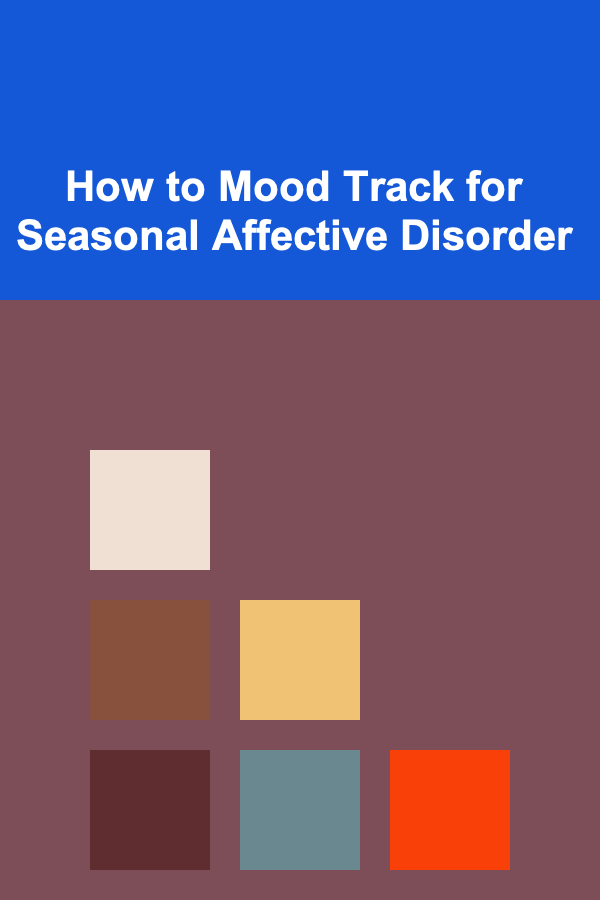
How to Mood Track for Seasonal Affective Disorder
ebook include PDF & Audio bundle (Micro Guide)
$12.99$11.99
Limited Time Offer! Order within the next:

Seasonal Affective Disorder (SAD) is a type of depression that occurs at specific times of the year, most often during the fall and winter months when daylight hours are shorter. This condition is more than just "winter blues" --- it is a clinically recognized form of depression that can seriously impact a person's quality of life. One of the most effective ways to manage SAD is through mood tracking. By keeping track of how you feel over time, you can identify patterns, triggers, and changes in your emotional and mental state, which can help you manage and alleviate the symptoms of SAD.
In this comprehensive guide, we will explore how to track your mood for Seasonal Affective Disorder. We will cover the importance of mood tracking, the best methods to track your mood effectively, and how this practice can help you manage your condition in the long run.
What is Seasonal Affective Disorder?
Before diving into mood tracking, it's important to understand what Seasonal Affective Disorder is and how it differs from other forms of depression.
1. Symptoms of SAD
SAD is typically marked by symptoms of depression that arise during the colder months of the year when there is less sunlight. Symptoms may include:
- Persistent feelings of sadness or hopelessness
- Loss of interest in previously enjoyed activities
- Difficulty concentrating
- Decreased energy or fatigue
- Sleep disturbances (such as oversleeping or difficulty waking up)
- Changes in appetite (usually cravings for carbohydrates or overeating)
- Weight gain
- Social withdrawal or isolation
While these symptoms can be severe and debilitating, they usually subside in the spring and summer months when sunlight exposure increases. However, without proper management, the symptoms may recur with each changing season.
2. Types of SAD
SAD is classified into two main types:
- Winter-onset SAD: This is the most common form of the disorder and typically occurs when days become shorter in the fall and winter.
- Summer-onset SAD: A rarer form, where depression symptoms appear during the warmer months, typically in spring or summer.
The vast majority of people with SAD experience it during the fall and winter, but understanding which type you are dealing with is crucial for your treatment and management plan.
Why Mood Tracking is Important for SAD
Mood tracking involves recording your emotional state over a set period of time. This practice is not just about noting when you're feeling sad --- it helps you identify emotional patterns, understand the severity of your condition, and assess how effective your coping strategies are. In the case of Seasonal Affective Disorder, mood tracking can be incredibly helpful in several ways:
1. Identify Patterns
Mood tracking helps you see patterns in your mood. For example, you may notice that your mood tends to dip during specific times of the year, or even on particular days of the week. By documenting this, you gain insights into when your symptoms typically worsen, and this can help you prepare for these changes.
2. Understand Triggers
SAD is often influenced by environmental factors, such as reduced sunlight exposure, cold weather, and shorter days. Mood tracking allows you to correlate your emotional fluctuations with these factors, helping you pinpoint potential triggers. Identifying these can help you take preventive steps, such as using a lightbox or increasing social engagement during dark days.
3. Track Treatment Effectiveness
If you're undergoing treatment for SAD --- whether it's light therapy, medication, or psychotherapy --- mood tracking is an invaluable tool for assessing progress. You can track how your mood changes in response to treatment, which can help you and your healthcare provider adjust your plan if necessary.
4. Motivate and Empower
It's easy to feel helpless when dealing with depression, but tracking your mood can help you see small improvements over time. When you're feeling low, reviewing past entries in your mood journal can remind you of times when you felt better, which can give you hope and motivation to continue your treatment plan.
How to Mood Track for Seasonal Affective Disorder
Now that we understand the importance of mood tracking, let's explore how to effectively track your mood for Seasonal Affective Disorder.
1. Choose Your Tracking Method
There are many ways to track your mood, and the method you choose should suit your preferences, lifestyle, and how much effort you are willing to put into the process. Here are a few options:
A. Pen and Paper Journals
The traditional method of tracking mood is to write down your feelings in a journal. Each day, you can write a brief entry detailing your mood, energy level, sleep patterns, and any significant events or feelings you experienced. You can rate your mood on a scale (e.g., 1-10) to quantify it, or you can simply write down how you felt using descriptive words.
Pros: Personalized, therapeutic, and free-form. A journal can also serve as a safe space for your thoughts and feelings.
Cons: It can be time-consuming, and you may forget to update it daily.
B. Digital Mood Trackers
There are many apps available that allow you to track your mood on a daily basis. Some apps even have features specifically designed for individuals with Seasonal Affective Disorder. These apps typically let you log your mood, energy level, sleep quality, and symptoms with ease. Examples of such apps include Moodpath, Daylio, and Reflectly.
Pros: Convenient, easy to update, and most apps allow for charts or graphs to track your progress over time.
Cons: Limited customization compared to pen and paper journaling, and potential privacy concerns.
C. Spreadsheets
A spreadsheet is another effective tool for mood tracking. You can create a simple spreadsheet with columns for the date, mood rating, energy levels, symptoms, sleep quality, and any other factors you'd like to track. You can also add a column for notes to provide context for your mood changes.
Pros: Highly customizable and great for those who like to analyze data.
Cons: May feel more impersonal than journaling and requires some time to set up.
D. Printed Templates
If you prefer something in between a journal and an app, you can print a mood tracker template. Many mental health websites offer printable mood trackers that you can fill out each day. These trackers usually include sections for rating your mood, symptoms, and other factors like weather, sleep, and social interactions.
Pros: Simple, no technology required, and provides a clear overview of your mood at a glance.
Cons: Not as flexible as other methods and requires manual tracking.
2. What to Track
When tracking your mood for Seasonal Affective Disorder, it's important to capture as many relevant details as possible. The more information you have, the better you can identify patterns and triggers. Here's what to include in your mood tracking:
A. Mood Rating
Track how you feel on a daily basis. You can use a numerical scale (e.g., 1-10), emojis, or descriptive words (e.g., sad, neutral, happy). The goal is to get a sense of how your emotional state fluctuates over time.
B. Energy Level
Note your energy level each day. People with SAD often experience fatigue, so tracking this can help you identify when your energy is lowest. Use a scale of 1-5 or a simple "low, medium, high" rating.
C. Sleep Patterns
Sleep is deeply connected to mood, especially in those suffering from SAD. Track your sleep duration and quality. Do you find yourself oversleeping or having trouble waking up? Are you sleeping through the night?
D. Symptoms of SAD
Record any physical or mental symptoms of SAD, such as increased cravings for carbohydrates, feelings of hopelessness, irritability, or withdrawal from social activities. Documenting these symptoms can help you see a clear picture of your condition.
E. Weather/Light Exposure
Because SAD is linked to a lack of sunlight, it's helpful to note the weather and your exposure to natural light. Were you able to spend time outside? Did the weather affect your mood? This can help you connect mood changes to the amount of sunlight you're getting.
F. Social Interaction
Social isolation is a common symptom of SAD. Track your social interactions and how they impact your mood. Did you meet up with friends or family? Did you feel better or worse afterward?
3. Review Your Data
At the end of each week or month, take time to review your mood tracker. Look for patterns --- do you tend to feel worse during particular weeks of the month or on certain days? Does your mood correlate with the weather or with specific activities, such as spending time outdoors or engaging in social interactions?
This data will not only help you understand your condition but also guide your treatment. If you see that certain behaviors or environments lead to improvements in your mood, you can intentionally incorporate more of these into your life.
4. Use Your Mood Tracking for Treatment
Share your mood tracking data with your healthcare provider, especially if you are undergoing treatment for SAD. Your provider can use this data to adjust your treatment plan, whether that involves changes in light therapy, medication, or therapy.
Mood tracking can also be an essential tool for self-care. If you notice that your mood is consistently low, you may need to ramp up your coping strategies, whether that's through exercise, spending more time in the sun, or practicing mindfulness and relaxation techniques.
5. Keep it Consistent
Consistency is key when mood tracking. The more data you collect, the clearer the picture of your emotional health will become. Make it a daily habit to track your mood, even if it's just for a few minutes. Over time, you'll gather enough data to make informed decisions about your care and well-being.
Conclusion
Mood tracking is an invaluable tool for managing Seasonal Affective Disorder. By identifying patterns, understanding triggers, and assessing the effectiveness of treatment, you can gain greater control over your emotional health during the darker months. Whether you choose a paper journal, an app, or a spreadsheet, the important thing is to remain consistent and stay engaged with the process. Through mood tracking, you can better navigate the challenges of SAD and take proactive steps toward feeling better, no matter the season.
Reading More From Our Other Websites
- [Personal Finance Management 101] How to Start Investing in Real Estate with No Experience
- [Home Rental Property 101] How to Rent a Home with a Screened Porch: Enjoying Outdoor Living Year-Round
- [Organization Tip 101] How to Master the Herringbone Tile Pattern in Your Home
- [Soap Making Tip 101] Lye-Free Luxury: Crafting Gourmet Soaps with Melt-and-Pour Bases
- [Rock Climbing Tip 101] From Hike-In to Top-Rope: Essential Etiquette Rules for Every Type of Climb
- [Home Rental Property 101] How to Create a Solid Property Maintenance Plan
- [Home Renovating 101] How to Install Smart Home Devices During a Renovation
- [Organization Tip 101] How a Whole-House Fan Can Improve Your Home's Airflow and Comfort
- [Small Business 101] Small Business Growth Hacks: How to Scale Without Losing Your Identity
- [Home Holiday Decoration 101] How to Choose Holiday-Themed Party Favors That Suit Your Festivities

How to Balance Work and Family Life for Busy Dads
Read More
How to Choose the Best Credit Card for Your Lifestyle
Read More
How To Create Explainer Videos with Animation
Read More
How to Declutter Your Bedroom for a More Peaceful Space
Read More
How to Tie Dye with Shimmer & Metallic Colors
Read More
How to Design Printable Wall Art for Small Spaces
Read MoreOther Products

How to Balance Work and Family Life for Busy Dads
Read More
How to Choose the Best Credit Card for Your Lifestyle
Read More
How To Create Explainer Videos with Animation
Read More
How to Declutter Your Bedroom for a More Peaceful Space
Read More
How to Tie Dye with Shimmer & Metallic Colors
Read More